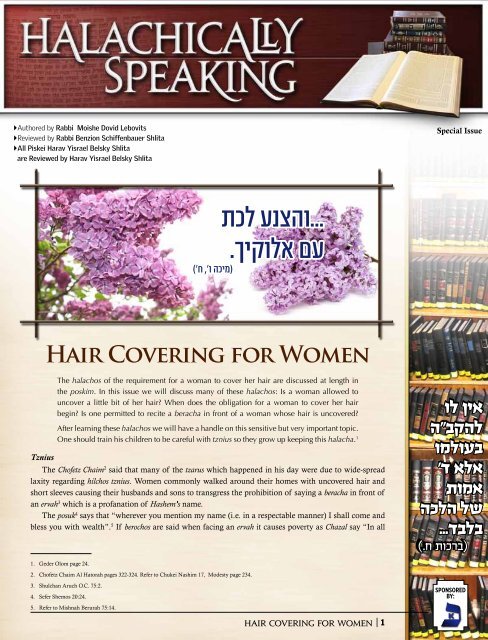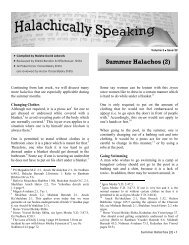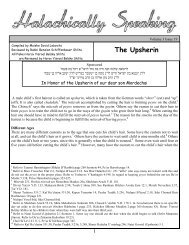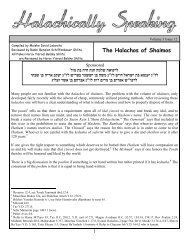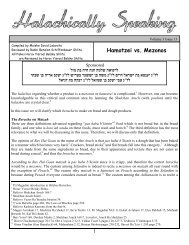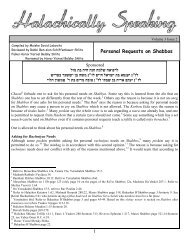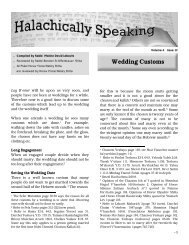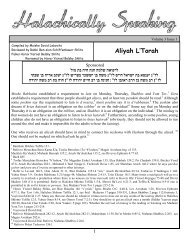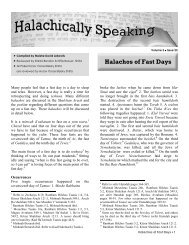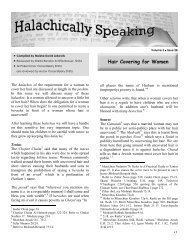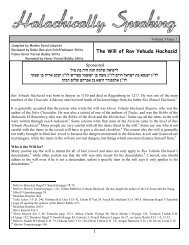Hair Covering for Women - The Shema Yisrael Torah Network
Hair Covering for Women - The Shema Yisrael Torah Network
Hair Covering for Women - The Shema Yisrael Torah Network
Create successful ePaper yourself
Turn your PDF publications into a flip-book with our unique Google optimized e-Paper software.
Authored by Rabbi Moishe Dovid Lebovits<br />
Reviewed by Rabbi Benzion Schiffenbauer Shlita<br />
All Piskei Harav <strong>Yisrael</strong> Belsky Shlita<br />
are Reviewed by Harav <strong>Yisrael</strong> Belsky Shlita<br />
Special Issue<br />
...והצנע לכת<br />
עם אלוקיך.<br />
)מיכה ו', ח'(<br />
<strong>Hair</strong> <strong>Covering</strong> <strong>for</strong> <strong>Women</strong><br />
<strong>The</strong> halachos of the requirement <strong>for</strong> a woman to cover her hair are discussed at length in<br />
the poskim. In this issue we will discuss many of these halachos: Is a woman allowed to<br />
uncover a little bit of her hair When does the obligation <strong>for</strong> a woman to cover her hair<br />
begin Is one permitted to recite a beracha in front of a woman whose hair is uncovered<br />
After learning these halachos we will have a handle on this sensitive but very important topic.<br />
One should train his children to be careful with tznius so they grow up keeping this halacha. 1<br />
Tznius<br />
<strong>The</strong> Chofetz Chaim 2 said that many of the tzarus which happened in his day were due to wide-spread<br />
laxity regarding hilchos tznius. <strong>Women</strong> commonly walked around their homes with uncovered hair and<br />
short sleeves causing their husbands and sons to transgress the prohibition of saying a beracha in front of<br />
an ervah 3 which is a profanation of Hashem’s name.<br />
<strong>The</strong> posuk 4 says that “wherever you mention my name (i.e. in a respectable manner) I shall come and<br />
bless you with wealth”. 5 If berochos are said when facing an ervah it causes poverty as Chazal say “In all<br />
אין לו<br />
להקב"ה<br />
בעולמו<br />
אלא ד'<br />
אמות<br />
של הלכה<br />
בלבד...<br />
ח.( )ברכות<br />
1. Geder Olom page 24.<br />
2. Chofetz Chaim Al Hatorah pages 322-324. Refer to Chukei Nashim 17, Modesty page 234.<br />
3. Shulchan Aruch O.C. 75:2.<br />
4. Sefer Shemos 20:24.<br />
5. Refer to Mishnah Berurah 75:14.<br />
<strong>Hair</strong> <strong>Covering</strong> <strong>for</strong> <strong>Women</strong> | 1<br />
SPONSORED<br />
BY: SPONSORED<br />
BY:
כל השונה הלכות בכל יום מובטח לו שהוא בן עולם הבא... )נדה עג.(<br />
SPONSORED<br />
BY:<br />
places the name of Hashem is mentioned (improperly) poverty is found.” 6<br />
Other se<strong>for</strong>im write that when a woman covers her hair it is a segula to have children who are yirei shomayim. 7 In<br />
addition one’s husband will be blessed with many berochos. 8<br />
Source<br />
<strong>The</strong> Gemorah 9 says that a married woman may not be in a public (or semi-public) place with her hair uncovered. 10<br />
<strong>The</strong> Medrash 11 says this is learnt from the posuk in parshas Noso 12 which says a Sotah is publicly humiliated by uncovering<br />
her hair. We see from here that going around with uncovered hair is a degradation since it is against halacha. Chazal<br />
tells us that a Jewish woman must cover her hair in public. 13<br />
<strong>The</strong>re is a discussion in the poskim if this issur is d’oraisa or d’rabbanan in nature. 14<br />
Reasons<br />
Many times people are asked why Jewish women cover their hair and have no answer. <strong>The</strong>re are numerous reasons<br />
why Jewish women cover their hair – we will list a few of them. By wearing a hair covering a woman conceals a<br />
natural source of attraction from the public and shows she is reserved <strong>for</strong> her husband. 15 Furthermore, hair grows in<br />
places that cause tava <strong>for</strong> men, and there<strong>for</strong>e it needs to be covered.<br />
At Home<br />
A woman in the privacy of her own home does not have to cover her hair. 16 <strong>The</strong> Gemorah 17 says that Kimchis<br />
was zocheh to have seven children who were kohanim gedolim since the four walls of her house never saw the hair of<br />
her head. Based on this the Zohar 18 (and other poskim) says that a woman should cover her hair even in her house. 19<br />
L’maseh, the Mishnah Berurah 20 says women should not be lenient with this inyun, and should cover their hair while<br />
at home as well. One reason is because her husband may need to recite berochos and if her hair is uncovered a beracha<br />
may not be recited (see below). 21 <strong>The</strong> Chazzon Ish is quoted as saying that the extent of a woman’s hair covering is the<br />
extent of her yiras shomayim. 22<br />
Based upon the Zohar many women have the custom to cover their hair while sleeping 23<br />
even though the covering will usually fall off.<br />
Exposing Partial <strong>Hair</strong><br />
Many poskim are of the opinion that absolutely no hair may be exposed when walking in public. 24 Horav Moshe<br />
6. Mesechtas Nedarim 7b. Refer to A Practical Guide to Tznius page 27. It also causes the yetzer hara to be present in one’s home (Mishnah Berurah ibid).<br />
7. Refer to Zohar Noso page 239, Geder Olom pages 19-21, Sharei Halacha U’minhag E.H. page 145, Teshuvos V’hanhugos 2:269:page 556 quoting the opinion of the<br />
Chasam Sofer, see Chut Shuni Shabbos 3:page 272.<br />
8. Zohar ibid, see Mishnah Berurah 75:14.<br />
9. Mesechtas Kesubos 72a-b.<br />
10. Refer to Mesechtas Kesubos 72a-b, Rashi on the Rif page 64, Rosh 7:9, Meiri Mesechtas Kesubos page 309, Rambam Hilchos Ishus 24:11-12, Issurei Biah 21:17,<br />
Encyclopedia Talmudis da’as yehudis 8:page 19.<br />
11. Medrash Rabbah Bamidbar 9:16.<br />
12. 5:18, see Rashi “u’para.”<br />
13. Mesechtas Kesubos ibid, Rashi “azhura,” Shulchan Aruch E.H. 21:2, Chai Adom 4:5, Igros Moshe O.C. 1:42, Yaskil Avdi 4:9:3.<br />
14. Refer to Terumas Hadeshen 10, Maharsham 4:138, Mishnah Berurah 75:10, Otzer Haposkim 21:2:24.<br />
15. Refer to Modesty pages 242-243.<br />
16. Taz 75:5, Shvili Dovid 75:2, Igros Moshe E.H. 1:58, Y.D. 2:75, O.C. 5:37:12. See Bnei Bonim 3:24. Refer to Lehoros Nosson 5:10:14 who is stringent.<br />
17. Yoma 47a. Refer to Modesty pages 23-24.<br />
18. Parshas Noso page 239.<br />
19. Magen Avraham 75:4, Kaf Ha’chaim 75:18, Chasam Sofer O.C. 36, Shevet Ha’levi 5:199:2, Divrei Chachumim page 261:54 quoting the opinion of Horav Chaim<br />
Pinchus Sheinberg Shlita, Chut Shuni Shabbos 3:page 272.<br />
20. O.C. 75:14, Biur Halacha “m’chutz l’tzmasam.”<br />
21. Modesty pages 232-233.<br />
22. Pe’er Hador 3:page 18.<br />
23. Zohar Parshas page 239, see Yalkut Shemonei Bereishis 347.<br />
24. Refer to Shulchan Aruch O.C. 75:2, E.H. 21:2, Magen Avraham 75:4, Maharam Elshakar 35:pages 158-160, Eishel Avraham Butchatch 75:2, Tzemach Tzedek 139,<br />
2 | HAlAchicAllY SpeAKiNg
Feinstein zt”l 25 is of the opinion that b’dieved a woman who exposed less than a tefach of hair did not transgress the<br />
prohibition of showing hair if she is not in a public place. 26 Even according to Horav Moshe, the amount which may<br />
be uncovered is less than two inches wide (an area of 3.5 inches, it does not mean 3.5 inches wide across the head).<br />
Accordingly the following should be noted:<br />
• A woman should be careful not to wear a snood that starts in the middle of her head. 27<br />
• A woman should be careful with certain caps if the hair protrudes out of the back of the cap. 28<br />
• A woman may not comb her own hair into her wig even if by looking at it one cannot tell that it is her own<br />
hair. 29<br />
<strong>Hair</strong> protruding from the Temple, Neck<br />
<strong>The</strong>re is a dispute among the poskim whether hair which grows next to the ear (sideburn hair) or on the bottom of<br />
the temple bone is exempt from the halacha of covering one’s hair. 30 Most poskim are of the opinion that such hair is<br />
exempt from the halacha. 31 <strong>Hair</strong> that grows on the neck is also exempt. 32<br />
According to all opinions a woman is allowed to have facial hair. 33<br />
To Whom Does this Halacha Apply<br />
Unmarried Girls/<strong>Women</strong> - In many communities unmarried women do not have the custom to cover their hair. 34<br />
However, there are some communities that have the custom that unmarried women should not go out in public without<br />
their hair braided. 35 <strong>The</strong> reason being because of tznius. However, most communities do not accept this minhag. 36<br />
One of the reasons why unmarried women do not have to cover their hair is because they have to look good <strong>for</strong> a<br />
prospective man to marry. However, a married woman who is an eishes ish has to hold back some of her beauty- chein<br />
from the public eye. 37<br />
<strong>The</strong>re is a dispute among the Sefardik gedolim whether an unmarried woman has to cover her hair when she recites<br />
any davar sh’bekedusha (e.g. shemonei esrei or birchos hamazon). 38 One should consult with their own Rav. However, the<br />
custom amongst Ashkenazim is to be lenient. 39<br />
Mishnah Berurah 75:10, Dovev Mesharim 1:124, Mahratz Chias 53, Teshuros Shai 1:51:1:page 12, Chasam Sofer ibid, Darchei Teshuva Y.D. 198:91, Igros Moshe E.H.<br />
1:58, 114, O.C. 4:112, Divrei Yisroel 1:33, Minchas Yitzchok 1:7, Maharsham 4:138, Yabea Omer E.H. 4:3:3, Chekel Yitzchok 81, Lehoros Nosson 5:pages 166-190 in great<br />
depth, Teshuvos V’hanhugos 1:62, 2, 692 (quoting the opinion of the Chazzon Ish), Bais Boruch 4:10:footnote *, Chut Shuni Shabbos 3:page 272, Minhag Yisroel <strong>Torah</strong><br />
(Nesuin) pages 52-53. Refer to Ketzos Ha’shulchan 1:page 90, Shevet Ha’Levi 5:195:1.<br />
25. E.H. 1:58. Refer to Igros Moshe O.C. 4:112:4.<br />
26. Horav Yisroel Belsky Shlita. Refer to Modesty pages 236-238 quoting the opinions of Horav Pam zt”l, Horav Dovid Feinstein Shlita, Horav Mattisyahu Solomon<br />
Shlita, Horav Korelitz Shlita, Horav Sheinberg Shlita, A Practical Guide to Tznius page 23. See Bnei Bonim 3:21-22<br />
27. Lev Ita page 6.<br />
28. Lev Ita ibid, see Sharei Halacha U’minhag E.H. page 143.<br />
29. Lev Ita ibid.<br />
30. Refer to footnote 24.<br />
31. Ben Ish Chai Bo 1:12, see Modesty page 230, Lehoros Nosson 5:page 181.<br />
32. Lev Ita page 2, Modesty page 230, A Practical Guide to Tznius page 24. Refer to Avnei Yushfei 3:107:3. <strong>The</strong> same is true <strong>for</strong> light colored hair which grows sparsely in<br />
the front of the head known as “baby hairs” (A Practical Guide to Tznius page 24).<br />
33. Shevet Ha’Levi 5:16:2.<br />
34. Rosh Mesechtas Berochos 3:37, Tur 75, Shulchan Aruch O.C. 75:2, Levush 2, Bach E.H. 21, Bais Shmuel E.H. 21:5, Be’er Heitiv 6, Chelkes Mechokek 2, Chai Adom<br />
4:5, Chasam Sofer Mesechtas Nedarim 30b, Teshuros Shai 2:38, Salmas Chaim 65, Chazzon Ish O.C. 16:8, Igros Moshe O.C. 4:112, Yechaveh Da’as 5:62, Koneh Bosem<br />
1:6, Machzei Eliyahu 9, Otzer Haposkim 21:2:page 31, Halichos Beisa 6:15:footnote 33.<br />
35. Magen Avraham O.C. 75:3, Shevet Ha’Levi 6:199, see Machtzis Ha’shekel 3, Mor V’ketziah 75, Atzei Chaim 6:page 6, Birchos Shomayim 1:32-33. <strong>The</strong> Bais Avi 2:32<br />
says if one is davening and is not sure if the woman in front of him is a single girl or married woman he may continue with his tefilla in any case (Refer to Rivevos Ephraim<br />
1:59).<br />
36. Opinion of Horav Tuvia Goldstein zt”l as related by Horav Webster Shlita. Refer to E’ven Yisroel 7:8, Koneh Bosem 1:6.<br />
37. Modesty page 243. Refer to Sheitels pages 18-26 in depth on this issue.<br />
38. Ben Ish Chai Shemenei 2:19, Yabea Omer O.C. 6:14:2, Yechaveh Da’as 5:6, Yaskil Avdi 7:page 289, Ohr L’tzyion 2:7:14:footnote 14.<br />
Refer to Halichos Bas Yisroel 5:footnote 6. Refer to Halichos Beisa 6:10:footnote 33 if a woman whose head is uncovered may answer amen to a beracha.<br />
39. Tzitz Eliezer 12:13, Rivevos Ephraim 6:page 571, Yabea Omer O.C. 6:15 quoting the opinion of Horav Elyashiv Shlita, Shevet Ha’kehusi 6:76, Halichos Shlomo Tefilla<br />
2:footnote 28, see Rivevos Ephraim 3:page 348:2.<br />
אין לו להקב"ה בעולמו אלא ד' אמות של הלכה בלבד... )ברכות ח.(<br />
SPONSORED<br />
BY:<br />
<strong>Hair</strong> <strong>Covering</strong> <strong>for</strong> <strong>Women</strong> | 3
Widow / Divorcee- A woman who is a widow r”l or divorcee 40 still has an obligation to cover her hair. 41 <strong>The</strong>re is<br />
a discussion among the poskim if a widow may be lenient with regard to covering her hair due to a possible financial<br />
loss. 42 Some poskim are of the opinion that since some non-Jews wear wigs due to health reasons there is no place to<br />
be lenient. 43 One should consult a Rav.<br />
Married Woman - Once a woman gets married she should be careful not to expose her hair even in front of her<br />
father or other close relatives. 44<br />
כל השונה הלכות בכל יום מובטח לו שהוא בן עולם הבא... )נדה עג.(<br />
SPONSORED<br />
BY:<br />
Not Wearing a Head <strong>Covering</strong><br />
In the time of chazal a man was permitted to divorce his wife without payment of her kesuba if she refused to cover<br />
her hair. 45 Although this does not apply today (since she is not covering her hair because she mistakenly believes that<br />
she is not obligated to do so, and not because she is disregarding the halacha), 46 one sees the severity of having a proper<br />
hair covering. 47<br />
Some women say there were many Rabbonim who let their wives go around without a proper hair covering. 48 Since<br />
we do not know the intent of these Rabbonim, this is not a reason <strong>for</strong> a woman to go around with her hair uncovered.<br />
<strong>The</strong>re are many other reasons why women would feel they do not want to cover their hair. 49 Some women say<br />
their mothers did not cover their hair and they are just following in the family tradition. Others say covering their hair<br />
causes headaches. Some women also do not want to look like Jews in public. 50<br />
<strong>The</strong>se reasons are not sufficient to permit a woman to walk in public with her hair uncovered. 51 Those who do so<br />
should speak with their Rav be<strong>for</strong>e continuing this practice.<br />
Saying Berochos etc in front of Exposed <strong>Hair</strong><br />
A woman who is supposed to have her hair covered and leaves it uncovered is regarded as an ervah to those in her<br />
presence. 52 <strong>The</strong>re<strong>for</strong>e, a man is not permitted to recite krias shema, etc in front of her. 53<br />
In the days of the Aruch Ha’shulchan the government said married women may not cover their hair. <strong>The</strong>re<strong>for</strong>e he<br />
held 54 that during that time hair was not considered to be an ervah since people became accustomed to seeing women<br />
with their hair uncovered. Based on this pesak, some say 55 that since nowadays it is common <strong>for</strong> women to walk<br />
around with uncovered hair, it is not considered an ervah. However, this should not be relied upon l’chatchilah since<br />
40. Prisha E.H. 21:3, Bais Shmuel E.H. 21:5, Pischei Teshuva 2, Aruch Ha’shulchan E.H 21:4, Ohr L’tzyion 1:11. Refer to Halichos Bas Yisroel 5:footnote 8 who quotes<br />
the opinion of Horav Shlomo Zalman Aurbach zt”l.<br />
41. Refer to Machzei Eliyahu 118.<br />
42. Igros Moshe E.H. 1:57, Yabea Omer E.H. 4:3, Machzei Eliyahu 118-119, Halichos Bas Yisroel 5:footnote 8 quoting the opinion of Horav Sheinberg Shlita, see Lev<br />
Avraham 107:pages 185-187.<br />
43. Opinion of Horav Tuvia Goldstein zt”l as related by Horav Webster Shlita.<br />
44. Horav Yisroel Belsky Shlita. Refer to V’ein Lumo Michshal 4:pages 215-216 who speaks about a daughter-in-law acting modestly in her in-laws house.<br />
45. Shulchan Aruch E.H. 115:4-5.<br />
46. Igros Moshe O.C. 1:43, E.H. 1:114, Lev Avraham 1:105, Yabea Omer Y.D. 4:1, see Dovev Mesharim 1:124:2, Yabea Omer E.H. 3:21.<br />
47. Igros Moshe E.H. 1:114. Some say one who knows his wife will not cover her hair has transgressed the issur of lifnei eiver since when the woman was single she had no<br />
obligation to cover her hair and now by marrying her you are making her transgress the issur of keeping her hair uncovered (V’ein Lumo Michshal 1:pages 120-121, Shevet<br />
Ha’Levi 9:284).<br />
48. Refer to Ben Ish Chai Bo 1:12, Journal of Halacha and Contemporary Society 30:page 105, Hide and Seek page 27.<br />
49. Refer to Hide and Seek pages 178-195.<br />
50. Refer to Geder Olom pages 10-12, also see Hide and Seek pages 179-183.<br />
51. Chofetz Chaim expressed in Geder Olom pages 5-6, Igros Moshe O.C. 1:43, Be’er Chaim Mordechai 52, Rivevos Ephraim 6:page 575, see Sdei Chemed mareches<br />
daled:page 361.<br />
52. Mesechtas Berochos 24a, Shulchan Aruch O.C. 75:2. Refer to Halichos Yisroel pages 263-268 in depth on this issue. This applies to even less than a tefach according to<br />
many poskim (Refer to Bais Boruch 4:pages 102-103).<br />
53. Shulchan Aruch 75:2, Maharsham 4:138.<br />
54. O.C. 75:7.<br />
55. Srdei Eish 2:14, Yabea Omer O.C. 6:13.<br />
4 | HAlAchicAllY SpeAKiNg
the gedolim frowned upon this heter. 56 Horav Moshe Feinstein zt”l 57 was in agreement with this heter, and said in a b’dieved<br />
case one can rely on it.<br />
According to the poskim who are more stringent, one who wishes to recite krias shema, etc. has to close his eyes<br />
when facing the uncovered hair of a woman. 58 Others say one is required to turn his body away from the direction of<br />
the uncovered hair. 59<br />
One is allowed to recite a beracha in front of a non-Jewish woman whose hair is uncovered. 60 One who does not<br />
know if the exposed hair belongs to a Jewish woman should judge by the majority of women in the area. 61<br />
A woman may recite a beracha in front of another woman whose hair is uncovered. 62<br />
Swimming Pool, Mikvah<br />
<strong>The</strong>re is a dispute whether a woman should cover her hair at the swimming pool. Some say (based on the Zohar<br />
mentioned above) that a woman should cover her hair at the swimming pool. 63 Others are lenient since there are only<br />
women around. 64 When a woman attends the mikvah her hair should be covered be<strong>for</strong>e reciting the beracha. 65<br />
When does the obligation begin<br />
<strong>The</strong>re is a dispute among the poskim when a woman is considered married in order to be obligated to cover her<br />
hair. 66 Most poskim are of the opinion that the obligation starts after erusin (after the man recites harei at.., and puts the<br />
ring on her finger). Based on this, a woman should cover her hair be<strong>for</strong>e the chupah to ensure it will be covered when<br />
the erusin is over. 67 Some say the obligation starts after yichud (following the wedding ceremony), 68 while other poskim<br />
are of the opinion that the correct time <strong>for</strong> a woman to cover her hair is the morning after the wedding. 69 Most bnei<br />
<strong>Torah</strong> follow the view of the later poskim and permit their wives not to cover their hair until the next morning. 70 <strong>The</strong><br />
custom of those attending Yeshiva Chofetz Chaim (Kew Garden Hills, N.Y.) is that their wives cover their hair be<strong>for</strong>e the<br />
chuppah. In chassidisha circles the custom is to have the woman cover her hair be<strong>for</strong>e the chuppah.<br />
56. Refer to Mishnah Berurah 75:10, Geder Olom page 6, Toras Chaim 75:2, Mei Yehuda O.C. 14, Shulchan Hatohar 9:9:4:page 83b, Teharas Yom Tov 1:pages 46-47,<br />
Yaskil Avdi O.C. 9:3, Mahari Shteiff 1:75, V’yeishiv Moshe 1:105, Machzei Eliyahu 9:3, Ohr L’tzyion 1:10, Sheitels pages 30-31, Piskei Teshuvos 1:75:5 in depth, see Igros<br />
Moshe O.C. 4:15.<br />
57. Igros Moshe O.C. 1:39, 1:42, 3:24, Lehoros Nosson 5:page 189. Refer to Ve’aleihu Lo Yeibol 1:page 286:4 who is lenient in this regard with saying zemiros on Shabbos in<br />
front of a woman whose hair is uncovered Refer to Yaskil Avdi ibid about saying the haggadah in front of a woman whose hair is uncovered. Refer to Bais Boruch Meluyim<br />
4:page 414 about being mesader kiddushin in the a<strong>for</strong>ementioned situation, see Modesty pages 374-375.<br />
58. Da’as <strong>Torah</strong> 75:page 127, Ketzos Ha’shulchan 1:page 90, Yechaveh Da’as 4:6, Teshuvos V’hanhugos 1:64. Refer to Tzitz Eliezer 15:11.<br />
59. Refer to Nemukei Orach Chaim 75:3, Salmas Chaim 60.<br />
60. Refer to Chai Adom 4:5, Mishnah Berurah 75:12, Igros Moshe O.C. 4:15, Yabea Omer 6:13:5, Rivevos Ephraim 1:58, Shevet Ha’kehusi 6:77. See Kaf Ha’chaim 75:16.<br />
61. <strong>The</strong> Laws of Daily Living page 79.<br />
62. Bais Yosef 75, Pri Megadim Eishel Avraham 1, Elya Rabbah 12, Ben Ish Chai Bo 1:9, Mishnah Berurah 75:8, Kaf Ha’chaim 75:11, Rivevos Ephraim 6:page 576, see<br />
Rama 75:1. One is permitted to recite a beracha in front of a woman who shaved off all of her hair (Halichos Yisroel page 268:footnote 6 quoting the opinion of Horav<br />
Chaim Kanievesky Shlita).<br />
63. Horav Yisroel Belsky Shlita, see Modesty pages 543, 547. <strong>The</strong> same applies while exercising (Modesty page 547).<br />
64. Based on the poskim quoted in footnote 62.<br />
65. Refer to Shulchan Aruch Y.D. 200, Ben Ish Chai Shemeni 2:19, Chuchmas Adom 121:14, Kaf Ha’chaim 63:13, Oz Nedberu 6:40, 8:50, Chut Shuni Niddah page<br />
327:3, Otzros Hatehara 6:114:footnote 301. This does not apply to a kallah who is going to the mikvah the first time be<strong>for</strong>e her wedding (Refer to Chut Shuni Niddah page<br />
327:footnote 4).<br />
66. Refer to Chovos Yuer 196, Shevus Yaakov 1:103, Pischei Teshuva E.H. 21:2, Nodeh B’Yehuda 2:79, Panim M’eros 1:35, Mishnah Berurah 75:11, Aruch Ha’shulchan<br />
E.H. 21:4.<br />
67. Kinyan <strong>Torah</strong> 2:43, Oz Nedberu 8:65, 12:50:1, 12:64, Yechaveh Da’as 5:62, Shevet Ha’Levi 9:259, Teshuvos V’hanhugos 4:294, Chut Shuni Shabbos 3:page 271,<br />
Emes L’Yaakov E.H. 55:footnote 25, Yismach Lev 1:page 164, Halichos Chaim 2:329:page 157, Chazzon Yeshaya page 339, Avnei Yushfei 3:107:2 quoting the opinion of<br />
Horav Elyashiv Shlita, Shraga Hameir 8:24, Ohr Yisroel 21:pages 30-33, Oles Yitzchok 2:233, Divrei Chachumim page 243:13 quoting the opinion of Horav Elyashiv Shlita,<br />
Opinion of Horav Tuvia Goldstein zt”l as related by Horav Webster Shlita.<br />
אין לו להקב"ה בעולמו אלא ד' אמות של הלכה בלבד... )ברכות ח.(<br />
68. Refer to Soveh Smochos 1:13:1-2, Otzer Haposkim 21:27:2, Yismach Lev 1:page 163.<br />
69. Horav Yisroel Belsky Shlita who also added that many of Horav Yaakov Kamenestky zt”l’s children had this custom. Refer to Chasam Sofer Y.D. 195, Mahari Shteiff<br />
48, Rivevos Ephraim 6:page 570, Avnei Yushfei 3:107:2, Teshuvos V’hanhugos 4:294, Ishei Yisroel 55:footnote 77, see Chasam Sofer Y.D. 195. Refer to Bnei Bonim 3:23.<br />
70. Horav Tuvia Goldstein zt”l heard this pesak from Horav Moshe Feinstein zt”l as quoted in Lev Ita page 87:footnote 4, and Divrei Chachumim page 243:13:footnote 13,<br />
Halichos Chaim 2 page 157:footnote 288 who quotes the opinion of Horav Aron Kotler zt”l, Opinion of Horav Avigdor Miller as related by Horav Webster Shlita. Refer to<br />
Gefen Porioh page 211.<br />
SPONSORED<br />
BY:<br />
<strong>Hair</strong> <strong>Covering</strong> <strong>for</strong> <strong>Women</strong> | 5
When One’s Wife is a Niddah<br />
<strong>The</strong>re is a dispute among the poskim if ones wife’s hair is considered an ervah during the time when she is a niddah.<br />
Some poskim are of the opinion that one may see his wife’s hair when she is impure, 71 however, other poskim are<br />
stringent in this issue. 72 One should consult with his Rav regarding this issue.<br />
כל השונה הלכות בכל יום מובטח לו שהוא בן עולם הבא... )נדה עג.(<br />
<strong>The</strong> Length of a Woman’s <strong>Hair</strong><br />
A unmarried woman should be careful not to wear her hair in an immodest fashion. 73 In regard to a married<br />
woman’s hair there are different customs. Among the chassidisha communities the minhag is that the women shave<br />
their hair completely. 74<br />
<strong>The</strong>re are many reasons <strong>for</strong> this custom. Some say the reason is because it should not be a chatzitzah when she<br />
attends the mikvah. 75 Others say the reason is because she should not come to uncover any of her hair. 76<br />
In the Litvisha circles 77 (and even some chassidisha communities) 78 the custom is that a married woman does not<br />
shave her hair. However, some advise <strong>for</strong> a woman not to let her hair grow long based on the above reasons. 79<br />
<strong>The</strong> Shaitel<br />
<strong>The</strong> topic of whether wearing a shaitel is permitted is discussed by many poskim and has been a topic of much<br />
debate. 80 Some say that a shaitel should not be worn because it is not a good covering since it is still the hair of<br />
a woman. Another area of debate is the human hair shaitel which looks exactly like one’s own hair. This will be<br />
discussed below.<br />
One of the reasons why a human hair shaitel is <strong>for</strong>bidden (according to these stringent opinions) is because it looks<br />
so real that it may appear one is not covering the hair at all. 81 Furthermore it is hard to tell the difference between a<br />
woman who is married and single since the shaitel looks like real hair. 82 While other poskim say it is permitted based on<br />
the following reason. This is because chazal said that a woman should cover her hair and it is covered when wearing a<br />
shaitel. While other poskim permit one to wear a shaitel as long as one has a covering over the shaitel because by doing<br />
so it takes away these reasons. 83 Some poskim only permit the wearing of synthetic shaitels because they do not appear<br />
to look like real hair. 84<br />
<strong>The</strong> minhag in most Ashkenazik communities is to permit a married woman to wear a shaitel 85 even if it looks like<br />
71. Igros Moshe O.C. 5:37:12, see Y.D. 2:75, Rivevos Ephraim 2:197:8, Opinion of Horav Tuvia Goldstein zt”l as related by Horav Webster Shlita, Teharas Habayis<br />
12:26:pages 164-166.<br />
72. Horav Yisroel Belsky Shlita, see Suga B’shoshanim page 215, Chut Shuni (Niddah) 295:pages 224-225, Shiurei Shevet Ha’Levi (Niddah) 195:7:2, Badi Ha’shulchan<br />
195:114, Halichos Bas Yisroel 5:footnote 5 quoting the opinion of Horav Elyashiv Shlita, Halichos Yisroel page 268, Otzros Hatehara 4:24. <strong>Hair</strong> of ones wife which is<br />
detached from her head is permitted to be looked at (Shevet Ha’kehusi 5:168).<br />
73. Mishnah Berurah 75:12.<br />
74. Chasam Sofer ibid, Darchei Teshuva Y.D. 182:12, 198:91, Birchos Shomayim 1:32:2. Refer to Igros Moshe E.H. 1:59 if the husbands custom is that the woman does<br />
not shave her head and his wife does have the custom.<br />
75. Refer to Teharas Yisroel 13:19:page 55 (new), Minchas Yitzchok 7:3.<br />
76. Shulchan Haezer 2:9:10:1, Igros Moshe Y.D. 2:88, Invei Hagefen 1:9:23, Shevet Ha’kehusi 1:237, Minhag Yisroel <strong>Torah</strong> Nesuin page 56, Lehoros Nosson 5:page 190.<br />
Some poskim were against this practice because it may render her ugly in the eyes of her husband. Furthermore, a woman does not have to fear that her tevillah will not be<br />
valid since there is always a woman making sure her immersion is valid (Igros Moshe Y.D. 2:88).<br />
77. Refer to Invei Hagefen 1:9:footnote 171, Sharei Halacha U’minhag E.H. pages 141-142, Gefen Porioh page 214, Teshuvos V’hanhugos 2:692. This is the custom of the<br />
Sefardim as well (Teshuvos V’hanhugos ibid).<br />
78. Tzemach Tzedek 139, Igros Moshe E.H. 4:100:4, Kinyan <strong>Torah</strong> 1:11.<br />
79. Opinion of Horav Tuvia Goldstein zt”l as related by Horav Webster Shlita. Refer to Biur Halacha 75 “m’chutz l’tzmasam.” See Modesty pages 262-266.<br />
80. Refer to Shulchan Haezer 2:9:10:7-11 <strong>for</strong> the opinions on this matter.<br />
81. Refer to Teshuvos Rav Yehoshua Leib Diskin (kuntres achron) 213:page 166, Shnos Chaim 316, Chasam Sofer 75:5, Divrei Chaim Y.D. 2:59, Teshuros Shai 1:570,<br />
Chesed L’Avraham E.H. 87, Bais Boruch 4:page 105, Shevet Ha’Levi 5:199:4, Modesty page 249 quoting the opinions of Horav Shlomo Zalman Aurbach zt”l, Horav<br />
Korelitz Shlita and Horav Elyashiv Shlita, Teshuvos V’hanhugos 4:294.<br />
82. Modesty page 251, V’yan Yosef 1:41, Halichos Shlomo Tefilla 20:footnote 12, see Invei Hagefen 1:9:25.<br />
83. Refer to Modesty pages 258-259.<br />
84. Chut Shuni Shabbos 3:page 273.<br />
SPONSORED<br />
BY:<br />
85. Refer to Shitei Geborim Mesechtas Shabbos page 29:1, Rama 75:2, Levush 2, Magen Avraham 75:5, Be’er Heitiv E.H. 115:10, Shulchan Aruch Harav 75:4, Teshuva<br />
M’ahavah 1:47, Mishnah Berurah 75:15, Aruch Ha’shulchan 6, Kaf Ha’chaim 19, Ohr Yisroel 21:pages 42-45, 93-96, 22:pages 29-66 in great depth, Sharei Halacha<br />
6 | HAlAchicAllY SpeAKiNg
one’s own hair. 86 However, in some chassidisha communities they permit a married woman to wear a shaitel if they<br />
have a covering over the shaitel. 87 While in some chassidisha communities they prohibit a married woman from wearing<br />
a shaitel completely. 88<br />
A woman may not wear a shaitel that is made out of her own hair. 89<br />
<strong>The</strong>re is a dispute in the Sefardik community whether a married woman may wear a shaitel due to the above reasons.<br />
Hagoan Horav Ovadia Yosef Shlita 90 is of the opinion that a married woman may not wear a shaitel but she should cover<br />
her hair with a tiechel etc. 91 and ensure that no hair should be showing. Other Sefardik poskim disagree and permit a<br />
Sefardisha married woman to wear a shaitel. 92<br />
Many Sefardisha women have the custom to wear a teichel to cover their hair and do not wear shaitel’s at all. 93<br />
Snoods/ Bandanas/Head Band<br />
Some women wear a snood that is crochet which may have large holes throughout and it does not cover the hair<br />
properly. 94 To make them wearable the snood must have lining. Some say the lining should be a different color in<br />
order to show that the snood has a lining. If it is a tight knit snood then it is permitted even without the lining. With<br />
regard to bandanas, if the bandana is very big and covers all her hair, without any loose hairs being exposed then it is<br />
permitted to be worn. 95 A bandana which is sewn closed in the back is permitted to be worn. 96<br />
It is permitted <strong>for</strong> a woman to wear a head band with a fall etc, as her hair is covered. <strong>The</strong> same thing would apply<br />
to wearing a bandana only if it used instead of a head band.<br />
Afterthought<br />
One who chooses to wear a shaitel should discuss with their Rav which ones are permitted and which are <strong>for</strong>bidden<br />
to be worn. Lately it has become common <strong>for</strong> many women to leave a lot of their hair uncovered and think by doing<br />
so it is permitted according to halacha. As mentioned above, one who is careful with this mitzvah will have children<br />
who will be yirei shomayim. This is something all of us want, and what better segula do we need than to be careful with<br />
the halachos of tznius. It is a husband’s obligation to tell his wife that a certain hair covering is or is not in the spirit of<br />
halacha. 97<br />
I would like to give a special thank you to Horav Yisroel Dov Webster Shlita (Dayan Yeshiva Emek Halacha –<br />
Rosh Av Beis Din of New York) <strong>for</strong> adding many insightful comments, and <strong>for</strong> loaning me his kuntres Lev Ita on this<br />
topic which was helpful to me in compiling this issue.<br />
U’minhag E.H. 50, see Journal of Halacha and Contemporary Society 30:pages 97-100, Shevet Ha’Levi 5:207:2, Hide and Seek pages 164-177 on the opinion of the<br />
Lubavitcher Rebbe zt”l on this topic.<br />
86. Rivevos Ephraim 6:page 574, Minhag Yisroel <strong>Torah</strong> Nesuin pages 53-56, Avnei Yushfei 5:145:4. <strong>The</strong> Practical Guide to Tznius page 26 is stringent. Horav Yisroel<br />
Belsky Shlita added that one should try to make sure the shaitel does not look too real.<br />
87. Minchas Elazar 5:35, Nemukei Orach Chaim 75.<br />
88. Refer to Sheilas Yaavetz 1:9, 2:7-8, K’rayana D’igirisa 2:124:page 132. See Journal of Halacha and Contemporary Society ibid:page 103.<br />
89. Mishnah Berurah 75:15, see Rivevos Ephraim 7:243.<br />
90. Yabea Omer E.H. 4:3:3, 5:5 meluyim pages 351-352, Soveh Smochos 1:pages 176-180:2, see page 177:footnote 2, Rivevos Ephraim 6:page 574, 8:82, Teshuvos<br />
V’hanhugos 2:692, 4:294:page 368. Refer to Orchos Rabbeinu 4:page 241:38.<br />
91. Refer to Modesty pages 254-255.<br />
92. Yaskil Avdi E.H. 7:16, Pnei Yitzchok E.H. 6:6, see Igros Moshe E.H. 2:12, Avnei Yushfei 5:145:1, Opinion of Horav Chacham Refoel Harari Shlita (Brooklyn N.Y.) as<br />
related by Horav Webster Shlita. Refer to Lev Ita page 4.<br />
93. Refer to Soveh Smochos 1:page 178-179, Rivevos Ephraim 6:page 574, Teshuvos V’hanhugos 2:692.<br />
94. Modesty pages 256-257.<br />
95. Sharei Halacha U’minhag E.H. pages 143-144, Avnei Yushfei 3:107:3, A Practical Guide to Tznius page 24.<br />
96. Avnei Yushfei ibid.<br />
97. Refer to Modesty pages 103-107, Teshuvos V’hanhugos 4:294:page 368.<br />
אין לו להקב"ה בעולמו אלא ד' אמות של הלכה בלבד... )ברכות ח.(<br />
SPONSORED<br />
BY:<br />
<strong>Hair</strong> <strong>Covering</strong> <strong>for</strong> <strong>Women</strong> | 7
A SMALL SAMPLING OF<br />
COMPANIES UNDER KOF-K<br />
KOSHER SUPERVISION
SPONSORED:<br />
לרפואה שלמה<br />
מרת רחל בת פעסיל<br />
Halachically Speaking<br />
volume 2.<br />
Do you<br />
have it<br />
already<br />
Hard-to-Find Halacha<br />
<strong>for</strong> Everyday Living<br />
HALACHICALLY SPEAKING<br />
Halachically Speaking is a monthly<br />
publication compiled by Rabbi Moishe<br />
Dovid Lebovits, a <strong>for</strong>mer chaver<br />
kollel of Yeshiva <strong>Torah</strong> Vodaath and a<br />
musmach of Harav Yisroel Belsky Shlita.<br />
Rabbi Lebovits currently works as<br />
the Rabbinical Administrator <strong>for</strong> the<br />
KOF-K Kosher Supervision.<br />
Each issue reviews a different area<br />
of contemporary halacha with an<br />
emphasis on practical applications of<br />
the principles discussed. Significant<br />
time is spent ensuring the inclusion of<br />
all relevant shittos on each topic, as well<br />
as the psak of Harav Yisroel Belsky, Shlita<br />
on current issues.<br />
WHERE TO SEE HALACHICALLY<br />
SPEAKING<br />
Halachically Speaking is distributed<br />
to many shuls in Flatbush, Lakewood,<br />
Five Towns, Far Rockaway, and Queens.<br />
It is sent via email to subscribers across<br />
the world.<br />
SPONSORED BY:<br />
SUBSCRIBE<br />
FOR FREE<br />
and view archives @<br />
www.thehalacha.com<br />
KOF-K Kosher Supervision<br />
To sponsor an issue please call<br />
718-744-4360<br />
© Copyright 2011<br />
by Halachically Speaking
Compiled by Rabbi Moishe Dovid Lebovits<br />
Policy/<br />
Updates<br />
Pas Yisroel List<br />
Cheshvan 5772<br />
Any questions regarding this list should be<br />
addressed to Rabbi Moishe Dovid Lebovits<br />
at 1- 201-837-0500 ext 127<br />
or mlebovits@kof-k.org<br />
Company Name<br />
Comments<br />
Company Name<br />
Comments<br />
Anthony and Sons<br />
Except PC# 1207<br />
and 2167<br />
Metrobuns<br />
All<br />
Automatic Rolls of Baltimore<br />
All<br />
Mid Atlantic Baking<br />
All<br />
Automatic Rolls of New Jersey<br />
All<br />
Nanas Cookie Co.<br />
All<br />
Bake – Rite<br />
All<br />
Oberlander Bakery<br />
All<br />
Canada Bread<br />
Certified Bakery<br />
Crispy Bagel Co.<br />
Food For Life<br />
Gabila Food Products Inc.<br />
H and S Bakery<br />
Only when the<br />
letters PY appear<br />
in the lotcode<br />
All<br />
All<br />
Except <strong>for</strong> the pita<br />
All<br />
Except Sandwich<br />
Flats and English<br />
Muffins<br />
Orthodox Baking<br />
Ottenbergs Bakery<br />
Pas Yisroel<br />
Schmidt Baking<br />
Scottos Pastry & Bakery<br />
Streits<br />
Sunrise Baking Co.<br />
All<br />
All<br />
All<br />
All<br />
All<br />
All<br />
All<br />
Hauswald’s<br />
All<br />
Tofutti Brands Inc.<br />
All<br />
Joeys Fine Foods<br />
Kerry Ingredient Co.<br />
All<br />
Only a few items<br />
call the KOF-K<br />
Tri State Buns<br />
All<br />
Please note: It is advisable to refer back to our website<br />
periodically since the items on this list are subject to change
Exciting<br />
News!<br />
1907<br />
located at 4704 Avenue N<br />
nowKOSHER<br />
is<br />
under


